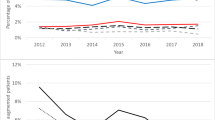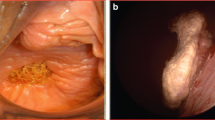Abstract
Since the 1990s, the use of mesh has expanded in gynecologic surgeries in the aim of correcting pelvic organ prolapse. Because there has been a lot of complications that were reported, the U.S. Food and Drug Administration has requested the withdrawal of many products from the market. Recently, many countries have called for the suspension of vaginal mesh products from the market. The objective of this review is to analyze the incidence of the complications that arise after vaginal mesh surgeries with an insight to the American College of Obstetricians and Gynecologists recommendations on the management of those complications.
Similar content being viewed by others
References
Davidson ER, Casas-Puig V, Paraiso MF, Ridgeway B, Ferrando C (2019) Pelvic organ prolapse recurrence and patient-centered outcomes following minimally invasive abdominal uterosacral ligament and mesh-augmented sacrohysteropexy. Female Pelvic Med Reconstr Surg. https://doi.org/10.1097/spv.0000000000000710(publish ahead of print)
Jelovsek JE, Maher C, Barber MD (2007) Pelvic organ prolapse. Lancet 369(9566):1027–1038. https://doi.org/10.1016/S0140-6736(07)60462-0
Scott NW, McCormack K, Graham P, Go PM, Ross SJ, Grant AM (2002) Open mesh versus non-mesh for repair of femoral and inguinal hernia. Cochrane Database Syst Rev 4:CD002197. https://doi.org/10.1002/14651858.cd002197
Bezerra CA, Bruschini H (2001) Suburethral sling operations for urinary incontinence in women. Cochrane Database Syst Rev 3:CD001754. https://doi.org/10.1002/14651858.cd001754
Debodinance P, Berrocal J, Clavé H et al (2004) Changing attitudes on the surgical treatment of urogenital prolapse: birth of the tension-free vaginal mesh. J Gynecol Obstet Biol Reprod (Paris) 33(7):577–588
Fatton B, Amblard J, Debodinance P, Cosson M, Jacquetin B (2007) Transvaginal repair of genital prolapse: preliminary results of a new tension-free vaginal mesh (Prolift technique)—a case series multicentric study. Int Urogynecol J Pelvic Floor Dysfunct 18(7):743–752. https://doi.org/10.1007/s00192-006-0234-3
Murphy M, Holzberg A, van Raalte H et al (2012) Time to rethink: an evidence-based response from pelvic surgeons to the FDA Safety Communication: “UPDATE on Serious Complications Associated with Transvaginal Placement of Surgical Mesh for Pelvic Organ Prolapse”. Int Urogynecol J 23(1):5–9. https://doi.org/10.1007/s00192-011-1581-2
Withagen MI, Milani AL, den Boon J, Vervest HA, Vierhout ME (2011) Trocar-guided mesh compared with conventional vaginal repair in recurrent prolapse: a randomized controlled trial. Obstet Gynecol 117(2 Pt 1):242–250. https://doi.org/10.1097/AOG.0b013e318203e6a5
Sung VW, Rogers RG, Schaffer JI et al (2008) Graft use in transvaginal pelvic organ prolapse repair: a systematic review. Obstet Gynecol 112(5):1131–1142. https://doi.org/10.1097/AOG.0b013e3181898ba9
Ellington DR, Richter HE (2013) Indications, contraindications, and complications of mesh in surgical treatment of pelvic organ prolapse. Clin Obstet Gynecol 56(2):276–288. https://doi.org/10.1097/GRF.0b013e318282f2e8
Milani AL, Damoiseaux A, IntHout J, Kluivers KB, Withagen MIJ (2018) Long-term outcome of vaginal mesh or native tissue in recurrent prolapse: a randomized controlled trial. Int Urogynecol J 29(6):847–858. https://doi.org/10.1007/s00192-017-3512-3
Mangir N, Roman S, Chapple CR, MacNeil S (2019) Complications related to use of mesh implants in surgical treatment of stress urinary incontinence and pelvic organ prolapse: infection or inflammation? World J Urol. https://doi.org/10.1007/s00345-019-02679-w
Gynecological mesh: The medical device that has 100,000 women suing. https://www.cbsnews.com/news/boston-scientific-gynecological-mesh-the-medical-device-that-has-100000-women-suing-2019-04-17/. Accessed 19 May 2019
Kaplan S, Goldstein M (2019) F.D.A. Halts U.S. sales of pelvic mesh, citing safety concerns for women. The New York Times. https://www.nytimes.com/2019/04/16/health/vaginal-pelvic-mesh-fda.html. Accessed 19 May 2019
(2017) Management of mesh and graft complications in gynecologic surgery. Female Pelvic Med Reconstr Surg 23(3):171–176. https://doi.org/10.1097/spv.0000000000000425
Manzano JP, da Crochik FS, Pugliesi FG, de Almeida RVS, de Melo PA, Nunes RLV (2019) Robot-assisted infratrigonal vesicovaginal fistula repair. Case Rep Urol. https://doi.org/10.1155/2019/2845237
Melody GF (1955) PARAVAGINAL HEMATOMAS—their recognition and management postpartum. Calif Med 82(1):16–18
Monib S, Ritchie A, Thabet E (2011) Idiopathic retroperitoneal hematoma. J Surg Tech Case Rep 3(1):49–51. https://doi.org/10.4103/2006-8808.78475
Lagerbäck T, Fritzell P, Hägg O et al (2018) Effectiveness of surgery for sciatica with disc herniation is not substantially affected by differences in surgical incidences among three countries: results from the Danish, Swedish and Norwegian spine registries. Eur Spine J Off Publ Eur Spine Soc Eur Spinal Deform Soc Eur Sect Cerv Spine Res Soc. https://doi.org/10.1007/s00586-018-5768-9
Kuponiyi O, Alleemudder DI, Latunde-Dada A, Eedarapalli P (2014) Nerve injuries associated with gynaecological surgery. Obstet Gynaecol 16(1):29–36. https://doi.org/10.1111/tog.12064
Al-Khodairy AWT, Bovay P, Gobelet C (2007) Sciatica in the female patient: anatomical considerations, aetiology and review of the literature. Eur Spine J 16(6):721–731. https://doi.org/10.1007/s00586-006-0074-3
Sorensen J, Bautista KE, Lamvu G, Feranec J (2018) Evaluation and treatment of female sexual pain: a clinical review. Cureus. https://doi.org/10.7759/cureus.2379
(2007) Stedman’s Medical Dictionary, 28th ed. Ref Rev 21(1):41–42. https://doi.org/10.1108/09504120710719671
Mock S, Reynolds WS, Dmochowski RR (2014) Trans-vaginal mesh revision: a comprehensive review on etiologies and management strategies with emphasis on postoperative pain outcomes. LUTS Low Urin Tract Symptoms 6(2):69–75. https://doi.org/10.1111/luts.12055
Mitchell L, King M, Brillhart H, Goldstein A (2017) Cervical ectropion may be a cause of desquamative inflammatory vaginitis. Sex Med 5(3):e212–e214. https://doi.org/10.1016/j.esxm.2017.03.001
Robinson D, Staskin D, Laterza RM, Koelbl H (2012) Defining female voiding dysfunction: ICI-RS 2011. Neurourol Urodyn 31(3):313–316. https://doi.org/10.1002/nau.22213
Aoki Y, Brown HW, Brubaker L, Cornu JN, Daly JO, Cartwright R (2017) Urinary incontinence in women. Nat Rev Dis Primer 3:17042. https://doi.org/10.1038/nrdp.2017.42
Author information
Authors and Affiliations
Corresponding author
Ethics declarations
Conflict of interest
Bassel Abouzeid, MD declares that he has no conflict of interest. Georges El Hasbani, MD declares that he has no conflict of interest. Imad Mufarrij, MD, MS, FACOG declares that he has no conflict of interest.
Ethical approval
This article does not contain any studies with human participants or animals performed by any of the authors.
Additional information
Publisher's Note
Springer Nature remains neutral with regard to jurisdictional claims in published maps and institutional affiliations.
Rights and permissions
About this article
Cite this article
Abouzeid, B., El Hasbani, G. & Mufarrij, I. Observational analysis of mesh related complications in urogynecologic procedures. J Robotic Surg 14, 377–382 (2020). https://doi.org/10.1007/s11701-019-01020-2
Received:
Accepted:
Published:
Issue Date:
DOI: https://doi.org/10.1007/s11701-019-01020-2




